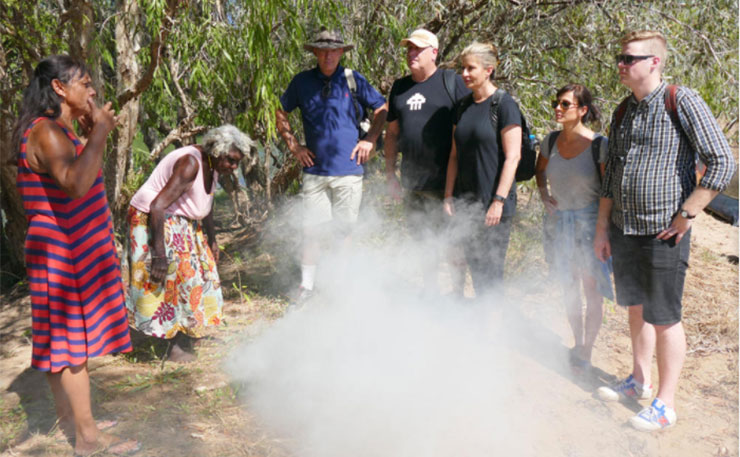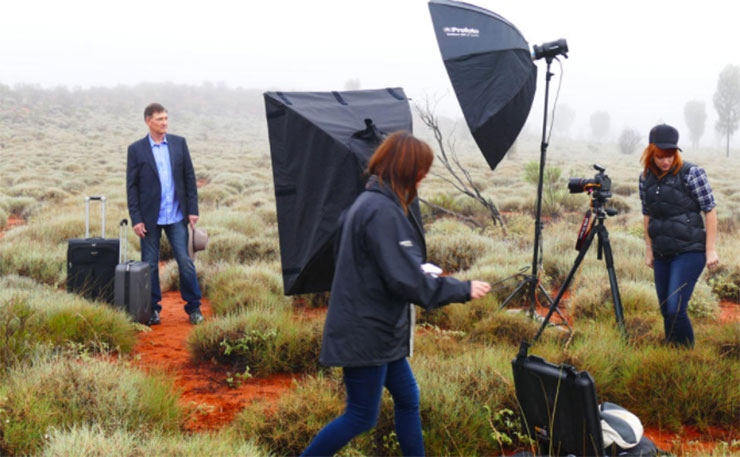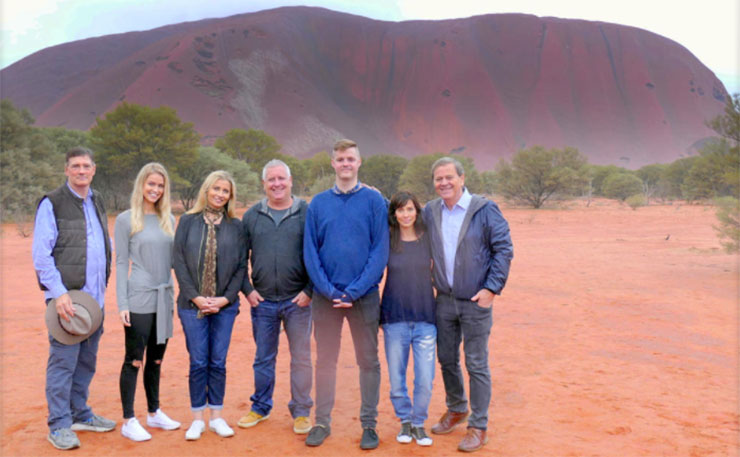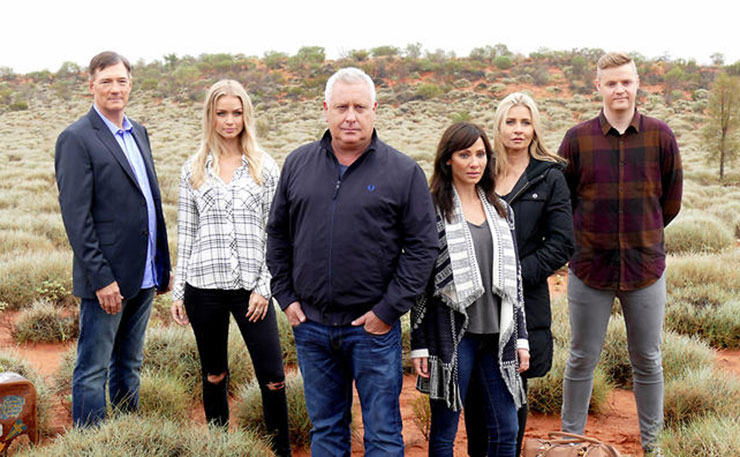The latest iteration of SBS’s exploration of ‘racism’ boldly goes where every other mainstream media outlet has already been, and none of it helps, writes Amy McQuire.
Last night the first episode of SBS’ ‘First Contact’ aired – the second incarnation of the series, this time featuring non-Indigenous ‘celebrities’, rather than a random selection of racists from around the country.
The synopsis though is the same – apparently one in six Australians claim they have little or no contact with Indigenous Australia, and so host Ray Martin is tasked with the ‘challenge’ of taking them on their own ‘journey’, allegedly to change hearts and minds.
The series is produced by Indigenous production house ‘Blackfella Films’ and supported heavily by National Indigenous Television. That has not shielded it from criticism, which has largely come from Aboriginal people, many of whom have cottoned on to the fact this wasn’t made with our best interests in mind.
When the first season of ‘First Contact’ aired a couple of years ago, mob quickly pointed out how emotionally taxing the format was. The onus was still on Aboriginal people to relive trauma for the entertainment of white people. The assumption was we had to ‘perform’ in order to change the ignorant views of racists who thought blackfellas get a ‘free ride’, who claimed we were ‘petrol sniffers’ and who thought others were hard done by because Aboriginal people somehow were ‘advantaged’.
The types of roles we could play in these performances, though, were limited, confined to ‘strong’, ‘resilient’ or ‘welcoming’. There was no room for dissent or truth. Even frustration was a stretch.

This sort of ignorance is not news to Aboriginal people – we confront it every single day. And so the idea that we must sit through the casual racism many of us encounter on a daily basis, under the guise we must ‘educate’ the ignorant, felt soul-destroying in itself.
You would think Blackfella Films, SBS and its supporter NITV would have learnt from the first season.
It hasn’t.
Last night assembled a cast of six – singer Natalie Imbruglia, personality Ian ‘Dicko’ Dickson, One Nation co-founder David Oldfield, former Ms Australia Renae Ayris, comedian Tom Ballard and actor Nicki Wendt.
All shades of Australian racism are represented, from the in-your-face undeniable racism of Oldfield, to the paternalistic, ‘knows-what’s-good-for-them’ Dicko, to the well-meaning ‘noble savage’ romanticism of Imbruglia. Ballard is a lone voice – the only one that understands his privilege, albeit in an academic sense.
Like the first series, the celebrity version does little to tackle the complexity of Australian racism, which is completely divorced from the history of this country.
In some scenes, the show completely fails to take on the most outrageous, disgraceful views of the show, instead choosing to reinforce stereotypes.
One example comes at the very start – when Oldfield claims Aboriginal culture “should have died out”.
“There’s just been too much BS about Aboriginality, culture: 60,000, 80,000, 50,000 years, there’s just too much BS attached to that,” he tells the camera.
“Is there something celebratory that you lived in the stone age longer than anyone else?
“It’s not actually good for Aborigines to remain Aborigines, they should be Australians and you just naturally let it die out. I mean frankly, it should have died out, like the stone age died out.”

Oldfield’s views are obviously extreme, but they are also views that are rooted in reality, and have currency in this country. This is a man, after all, who was elected to NSW parliament once, and to Manly Council twice.
International tribal advocacy group Survival International runs a campaign against the use of terms like ‘stone age’ in the media, labelling it as ‘incorrect and very dangerous’.
“It is dangerous because it is often used to justify the persecution or forced ‘development’ of tribal peoples. The results are almost always catastrophic: poverty, alcoholism, prostitution, disease and death,” the group says.
And Oldfield’s claims are dangerous precisely because it echoes history. The idea that Aboriginal culture should just ‘die out’ because it is ‘stone age’ and ‘primitive’ plays into every racist assumption that has laid the foundation for genocidal policies – from rounding blackfellas into missions and reserves to ‘smooth the pillow of a dying race’, to the policies of forced removal, to the current day – where assumptions of Aboriginal culture as ‘violent’ justified a full scale military intervention into the Northern Territory.
But rather than confront this racist and damaging ‘stone age’ characterisation by Oldfield, Ray Martin instead jumps ahead, using the defeatist, deficit language to paint Aboriginal people as devoid of agency, stripped of humanness.
He does this by first outlining horrific statistics of family violence and suicide – statistics Aboriginal people know intimately from personal experience. And then he frames it like this:
“The core of the problem is poverty, booze and depression. I told you it was going to be confronting,” he says.
That is not the ‘core of the problem’, but it is very convenient for Martin. It eases the discomfort of the six, even though they should apparently be prepared to be ‘shocked’, because it completely removes them from the equation. They are seen as bystanders to oppression, even though their prosperity means they are directly implicated in it.

And then Martin simply whisks them away to a sobering up shelter in Kununurra, Western Australia to begin their trauma tour. This is designed to wring enough emotional responses to justify the program’s expenditure, while ignoring the root causes of ‘poverty, booze and depression’.
The ‘shock’ comes in ‘confronting’ the six with the consequences of addiction, rather than ‘shocking’ them with the reality of how mob fall into addiction. There is limited conversation on the trauma, but nothing on where this trauma stems from.
In this series, Aboriginal people are portrayed as people who have bad things happen to them. They are seen as shallow caricatures to which non-Aboriginal people can glean ‘experience’. Trauma of both the past and the present is a pit stop on the ‘journey of discovery’.
This was obvious in the next stage of the ‘journey’ – where the six are taken to a gathering of a suicide support group. There they listen to harrowing stories of youth suicide from two strong women who have lost children in their family, including hearing the story of an 11-year-old committing suicide.
“After that we just lost one after the other… To me it’s just a normal thing in life,” Jennifer Wilson tells the group.
There is no further discussion of why there is a prevalence of suicide, just as there is only limited discussion of the trauma that underlies alcohol and drug addiction. They cry, but they move on, because this is just one stage in their journey.
The six are then flown to the picturesque homeland community of Bawaka, in East Arnhem Land, for their ‘cultural experience’. There they fish, hunt, dance and are painted in ochre. It is here where Oldfield’s views are framed as distant from the group, as somehow marginal and not shared by the others. He is seen as ‘on the extreme end’, on the unreasonable end of the spectrum of racism, because of his obvious disdain for Aboriginal culture.
But while the others seem content with their cultural experience, and blown away by the beauty and strength of Aboriginal culture, the really uncomfortable truths are never even hinted at. They are happy when mob are welcoming them, when they are receiving an experience befitting a tourism brochure, but the really destructive nature of Australian racism – the type that prioritises development over land rights, capital over culture – is never exposed. The fact that there has been a continual assault on the right to live on country, to practice culture, to care for homelands, particularly in the Northern Territory – is never explained to the six, nor to viewers.
The links between this group’s ignorant, bigoted assumptions of right to land and ceremony is never shown, even though the whole point of dehumanising Indigenous people was to justify the theft of that very land.
And that’s what Australian racism thrives on – the dehumanisation of Aboriginal people, it is given new life through painting Aboriginal people as ‘victims’, as degenerates, as incapable of agency and control. That dehumanisation helped justify the colonial project – the stealing of land, the attack on culture, and the slaughter of our people. All of this is tied up in the founding of this country, and the wealth it enjoys.
All of these ‘well-known’ Australians are successful, and they are successful because of the oppression of Aboriginal people. They live in the ‘lucky country’, precisely because there are those who were ‘unlucky’.
The racism on show is a direct descendant of the racism that justified this theft.
But I guess the fact this is never acknowledged is not surprising, because like all ‘reality TV’ this is not about reality.
Anything that purports to confront racism, but fails to push the participants to look inwardly -– to consider their own history, their own complicity, their own prosperity and the structures that benefit them, and belittle others – is simply entertainment.
Donate To New Matilda
New Matilda is a small, independent media outlet. We survive through reader contributions, and never losing a lawsuit. If you got something from this article, giving something back helps us to continue speaking truth to power. Every little bit counts.





